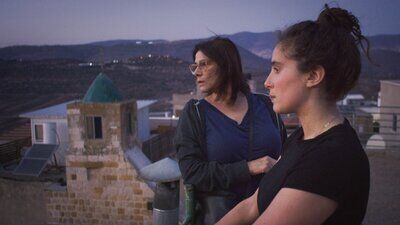Barghouti’s family, longing for him, speak as though he will find release. The more profound point here, present in all the films of this Festival, is that as they watch the Occupiers seize their towns, their homes, and their bodies, the Palestinians cannot help but persist. His resistance, whether from a rooftop speech or torture in solitary confinement in Israeli prisons, was not against Israel but against the Occupation.
For a brief history of the plight of the Palestinians, Joshua Vis and Eric Schrotenboer’s film “The Law and the Prophets” provides journalist research through what at first seem to be ancient relics but are really former homes of displaced Palestinians. From there, we follow a full history not often taught. Highly stylish with modern graphics, you cannot help but to feel for the calculated, deliberate dispossession of the Palestinian peoples from their homes.
Modern mainstream news coverage tends to be more sympathetic to the Palestinians than ever, yet still depicts the Palestinians as the primary cause of their own suffering. Vis and Schrotenboer’s film shows that the plight of the Palestinians is a generations-long erasure by multiple global powers without anyone intervening for them.
Among the common terminologies and images in so many of these films is the concept of the Nakba, being the “catastrophe” of Israeli occupation. Nearly every film likewise features the checkpoints Palestinians need to give half of their days to; the odd wall that winds through the region, stealing Palestinian territory; faceless, nameless, fully-armed Israeli soldiers resembling the fascists from dystopian movies, breaking into homes. In nearly every film, the Palestinians live in an open-air prison, exercising their resistance to Occupation in their own ways.
Likewise, among the short films, “High Roads” features women who run, stretch, swim, and research as their forms of resistance. The astronomers look to the cosmos as though it is their only access to freedom. In “Jabal,” young men entertain each other with ridiculous jokes in this road movie as they look for a lost population. In “Jamila,” a young American-Palestinian woman connects with her aunts seemingly through hair care but actually through shared sorrow. In “Dakhla,” a young Palestinian wonders from afar about his homeland and its chaos, reflecting on his identity through what may be a sentiment of survivor’s guilt. In “Pulse of Palestine,” we tour Nablus’ historical culture, as well as the roots of its activists and fighters.
As I write this article, I wonder where we will be in a year. What will remain of Palestine? Who will remain of indigenous Palestinians? I must admit that I am far more pessimistic than the filmmakers featured in this festival and the Palestinians they portray. These films capture that determination.

